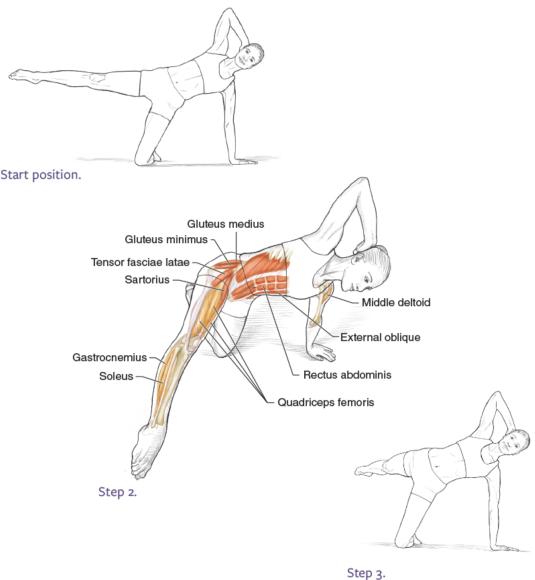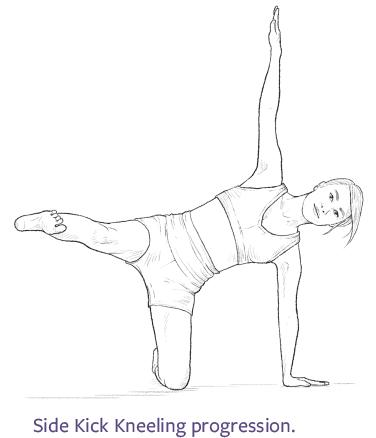Pilates side kick kneeling
This is an excerpt from Pilates Anatomy-2nd Edition by Rael Isacowitz,Karen Clippinger.
Intermediate
8-2
Side Kick Kneeling

Execution
- Start position. Kneel and bend the trunk to the side. Place one palm on the mat, with the fingers pointing away from the knee. Place the other hand behind the head, with the elbow bent and pointing toward the ceiling. Lift the top leg (the leg farthest from the support arm) to about hip height.
- Inhale. Bring the raised leg forward. See the main muscle illustration.
- Exhale. Bring the raised leg backward as shown. Repeat the sequence five times. Do the same on the opposite leg.
Targeted Muscles
Spinal lateral flexors and stabilizers: external oblique, internal oblique, quadratus lumborum, erector spinae (spinalis, longissimus, iliocostalis), semispinalis, deep posterior spinal group, rectus abdominis, transversus abdominis
Hip abductors: gluteus medius, gluteus minimus, tensor fasciae latae, sartorius
Accompanying Muscles
Hip flexors: iliopsoas, rectus femoris
Hip extensors: gluteus maximus, hamstrings
Knee extensors: quadriceps femoris
Ankle-foot plantar flexors: gastrocnemius, soleus
Shoulder abductors: middle deltoid, supraspinatus
Scapular depressors: lower trapezius, serratus anterior (lower fibers)
Scapular abductors: serratus anterior
Elbow extensors: triceps brachii
Technique Cues
- Throughout the exercise, think of the body forming an arc from the head to the support knee. Press into the mat with the hand, and use the shoulder abductors to help lift the upper trunk, the spinal lateral flexors on the side of the body closest to the mat to lift the spine, and the hip abductors to lift the lower side of the pelvis, all to help form this arc.
- As you press into the mat, use the elbow extensors to keep the elbow straight while keeping the lower scapula down and reaching toward the mat with the use of the scapular depressors and abductors, particularly the serratus anterior.
- Maintain a long line of the raised leg as it swings, using the knee extensors to straighten the knee and the ankle-foot plantar flexors to point the foot.
- Focus on keeping the raised leg at the appropriate height by using the hip abductors of the top leg while the hip flexors bring the leg forward and the hip extensors bring it slightly back.
- Imagine. Think of the body as an arched bridge, with the arm providing an upright support as the leg swings freely forward and backward without disrupting the strong bridge structure.
Exercise Notes
Side Kick Kneeling offers many of the same benefits as Side Kick (exercise 8-1), but it increases the stability challenge because you are supported by just one knee and one straight arm. It also increases the work of the spinal lateral flexors on the side closest to the mat, particularly the obliques, to maintain the side-arched position of the trunk. Last, it provides important practice for using the shoulder abductors and scapular stabilizers on the support arm, a skill that is used in a much more difficult manner in the Side Bend (exercise 8-3) and Twist (exercise 8-6).
Personalize Your Practice
Modification
One of the difficult aspects of Side Kick Kneeling is maintaining a consistent height of the moving leg. The leg tends to dip as it transitions from front to back and vice versa. To practice keeping the leg at a consistent height, choose a less challenging height, even if it is below the level of the upper hip joint. Now move the leg as described in steps 2 and 3, maintaining the same distance to the mat as if sliding along a tabletop.
Variations
Perform the exercise with the support knee almost directly under the hip joint and the swinging leg held as high as possible to add greater challenge to the hip abductors. A double-leg pulse and the foot positioning and percussive breath pattern described in the Side Kick (exercise 8-1) variations can also be used.
Progression
Using the position described in Side Kick Kneeling variations, reach the fingers of the upper arm toward the ceiling instead of keeping them behind the head. This position, besides being interesting aesthetically, further challenges the stability of the body, helps maintain an open position of the chest, and works the upper shoulder in keeping the arm up and stable.

SHOP

Get the latest insights with regular newsletters, plus periodic product information and special insider offers.
JOIN NOW


